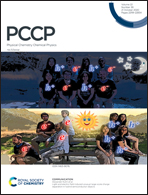To probe the binding pathway of a selective compound (D089-0563) to c-MYC Pu24 G-quadruplex using free ligand binding simulations and Markov state model analysis†
Abstract
D089-0563 is a highly promising anti-cancer compound that selectively binds the transcription-silencing G-quadruplex element (Pu27) at the promoter region of the human c-MYC oncogene; however, its binding mechanism remains elusive. The structure of Pu27 is not available due to its polymorphism, but the G-quadruplex structures of its two shorter derivatives in complex with a ligand (Pu24/Phen-DC3 and Pu22/DC-34) are available and show significant structural variance as well as different ligand binding patterns in the 3′ region. Because D089-0563 shares the same scaffold as DC34 while having a significantly different scaffold from Phen-DC3, we picked Pu24 instead of Pu22 for this study in order to gain additional ligand binding insight. Using free ligand molecular dynamics binding simulations (33 μs), we probed the binding of D089-0563 to Pu24. Our clustering analysis identified three binding modes (top, side, and bottom) and subsequent MMPBSA binding energy analysis identified the top mode as the most thermodynamically stable. Our Markov State Model (MSM) analysis revealed that there are three parallel pathways for D089-0563 to the top mode from unbound state and that the ligand binding follows the conformational selection mechanism. Combining our predicted complex structures with the two experimental structures, it is evident that structural differences in the 3′ region between Pu24 and Pu22 lead to different binding behaviors despite having similar ligands; this also explains the different promoter activity caused by the two G-quadruplex sequences observed in a recent synthetic biology study. Based on interaction insights, 625 D089-0563 derivatives were designed and docked; 59 of these showed slightly improved docking scores.



 Please wait while we load your content...
Please wait while we load your content...